Last updated: September 6, 2024
Article
Fire from the Sky: USS Cassin Young and the Okinawa Campaign
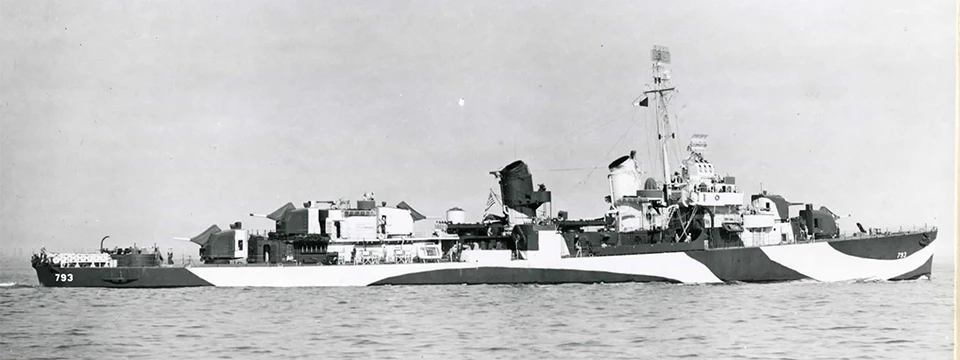
National Archives - NAVAER 381582
Prelude to Okinawa
Combat in the Pacific Theater of World War II lasted 1,368 days and involved not just Japan and the United States, but Great Britain and its Imperial territories, Australia, Canada, New Zealand, the Netherlands, China, France, and, in the final days of the war, the Soviet Union. It was fought over vast distances, from Alaska to Australia and from Ceylon to California.
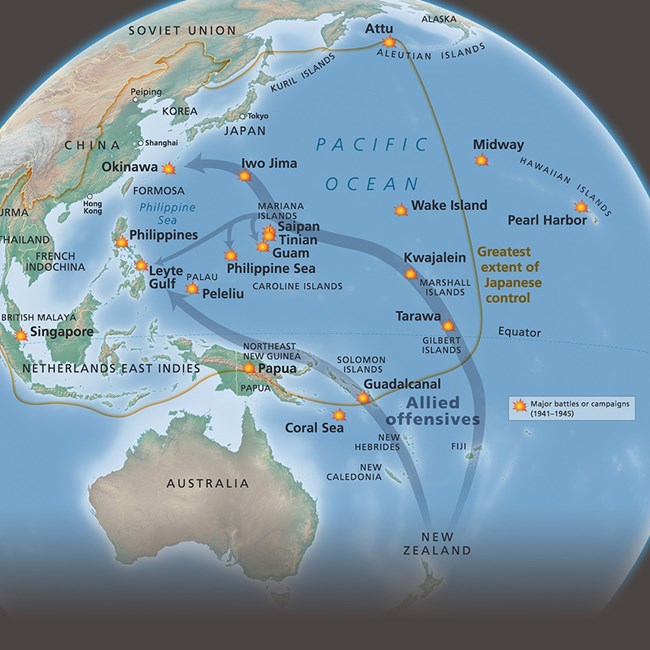
NPS: Harpers Ferry Center/War in the Pacific NHP
World War II, as a European conflict, began in 1939—two years before the entry of the United States. War in the Pacific, excluding the Sino-Japanese War which started in 1937, commenced on December 7, 1941, when Japanese planes attacked Pearl Harbor in Hawaii. Over the next six months, Imperial Japan rapidly advanced across the Pacific. American victories at the Battles of Coral Sea and Midway finally checked this momentum. Land warfare in the China-Burma-India Theater, coupled with numerous naval actions and island-hopping campaigns in the Aleutians, the Central Pacific, and the South Pacific resulted in U.S. forces invading the Mariana and Philippine Islands by 1944. In October 1944, the Battle for Leyte Gulf, the largest naval engagement in world history, resulted in the near destruction of the Imperial Japanese Navy. In the aftermath of this battle, the new Japanese tactic of the kamikaze ("divine wind") air attacks began. Pilots began to deliberately fly their planes into enemy ships. Initial attacks on U.S. ships following Leyte Gulf intensified during landings on Mindoro Island and Lingayen Gulf in the Philippines. These landings saw kamikaze attacks succeed in sinking 24 vessels and damaging 67 others. When a kamikaze crashed into the side of the Boston Navy Yard-built Fletcher-class destroyer USS Haraden (DD-585), the destroyer was severely damaged. Her forward engine room was out of commission, 14 men died, and 24 more members of her crew were wounded. When kamikaze planes struck the Australian cruiser HMAS AUSTRALIA five times, the ship was knocked out of action for months.
Fire From the Sky
The relative success of kamikaze attacks in the Philippines led to their greater use in the Battle for Okinawa. Japanese strategists realized a prolonged and costly land battle against American forces would pin down thousands of U.S. and Allied ships near the island. Thus constrained, these naval forces were highly vulnerable to aerial attack. The plan was to employ 10,000 Japanese aircraft, of which half would be kamikazes. The four-month long campaign would confirm that the rate of success in sinking or damaging ships was much greater than by conventional air attack. Japanese Navy Captain Rikihei Inoguchi wrote after the war, “considering the heavy odds our pilots faced, their chances of coming back alive from any sortie was very slim. If one is bound to die, what is more natural than to die effectively, at maximum cost to the enemy.”
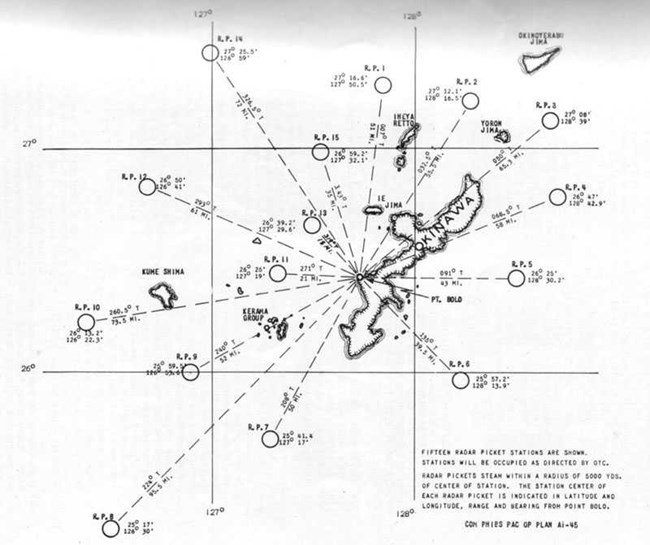
Navy History and Heritage Command:
Battle Experience: Radar Pickets and Methods of Combating Suicide Attacks Off Okinawa
A combination of single plane attacks interspersed with mass-formation attacks called kikusui ("floating chrysanthemums") were launched beginning in late March 1945. The first potential target that the Japanese airmen often saw were dangerously exposed American destroyers. The destroyers were located at 16 radar picket stations encircling the island of Okinawa. Using their air search radar, these destroyers would identify approaching Japanese planes and warn the main fleet off of Okinawa. But these picket destroyers, primarily out on their own, lacked the ability to realistically shoot down swarms of kamikazes attempting to sink them.
Starting on April 3, 1945, USS Cassin Young (DD-793) took up position at Radar Picket Station 3. This, along with picket stations 1 and 2, were the hottest sectors directly in the path of kamikazes flying southwest from the main islands of Japan toward Okinawa. Navigation Officer George T. Finnegan recalled the strain of being aboard Cassin Young at this time, “It was a tremendous psychological experience to be on a radar picket station, just to be on it. You were just living from one minute to the next because you knew they were coming in, but you weren’t sure when”.
On April 6, 1945, kikusui #1 commenced. Upwards of 85 kamikazes attacked the destroyers Bush, Colhoun and Cassin Young guarded Radar Picket Stations 1, 2 and 3, respectively. Cassin Young downed three ‘bogeys’ (enemy planes) and assisted Bush (DD-529) and Colhoun (DD-801). The latter two destroyers sank after each ship was hit by several kamikazes. Ralph Samuel Rhoads kept a diary while aboard Cassin Young in 1944-45 and described the action. Colhoun “took five planes on her infrastructure and main deck and was close to sinking when we arrived. Two LCS [L] (Landing Craft Support, Large) picked up survivors and then we finished her with 5-inch gunfire.” After one hour of firing 246 shells into Colhoun, the destroyer finally went down.
USS Emmons (DMS-22) shot down seven kamikazes before she was hit in quick succession by three planes. Beyond saving, USS Ellyson (DMS-19) sank her. Emmons suffered 81 killed and 77 wounded. The Boston Navy Yard-built Fletcher-class destroyer Newcomb (DD-586) came close to being the fourth destroyer lost that day. Hit by four kamikazes, Newcomb was reduced to a wreck, but remained afloat. It took an hour to control the fires before being able to be taken under tow to Okinawa. Thirty-nine men were killed and 67 wounded in the attack. All told, 355 kamikazes involved on the April 6 attack sank four vessels and damaged 20 others.
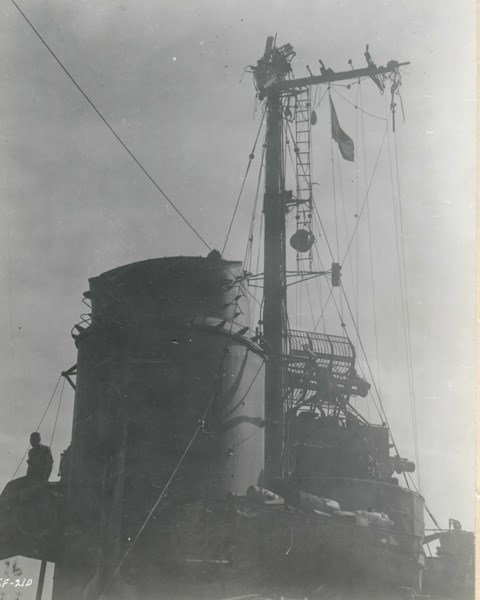
NARA: NAVAER 330115
Cassin Young's First Hit
Kikusui #2 launched the morning of April 11 and continued for two days. By sunset on April 12, more than 300 kamikazes sank only one destroyer but damaged 19 other vessels. Among those damaged included Cassin Young. Assigned to Radar Picket Station 1 on April 12, six kamikazes attacked her that day. Five were shot down, but the sixth hit the foremast. The bomb on the plane exploded 40 feet above the ship, showering the decks with debris and shrapnel. One sailor was killed and 59 were wounded.
The one destroyer lost that day, Mannert L. Abele (DD-733), was obliterated in dramatic fashion by the successful use of a piloted rocket bomb known as Ohka ("cherry blossom"). One conventional kamikaze had already hit the ship when an Ohka launched from the belly of a Japanese bomber. Streaking towards the destroyer at over 600 miles an hour, it struck the forward fire room of Mannert L. Abele. The explosion split Mannert L. Abele in two and it sank in five minutes. Seventy-nine men were killed and 35 were wounded.
Following the April 12 hit, necessary repair work kept Cassin Young off the dangerous picket duty until mid-July. By that time, organized resistance by Japanese Army on Okinawa had ended. Massed kikusui attacks on the fleet also ended, as the Japanese military began to reserve aircraft to resist an impending invasion of Japan. Yet individual kamikaze attacks remained a constant threat. On July 29, 1945, Cassin Young picked up survivors from her sister Fletcher-class destroyer USS Callaghan (DD-792) which sank after being hit by an ancient fabric and wood biplane. Forty-seven men were killed or missing, and 73 were wounded. Cassin Young picked up 125 Callaghan survivors (other destroyers also plucked some sailors from the ocean), brought them to the Hagushi anchorage on the west side of Okinawa, and there transferred those survivors to another vessel. Cassin Young then sailed around the southern tip of Okinawa to the east side and the main Buckner Bay base to rearm and refuel. Again, ready to fight, she left there and sailed southwest to another picket station.
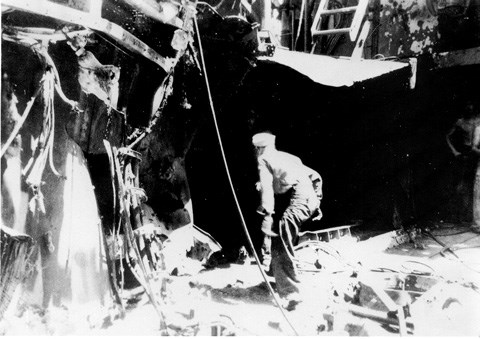
NPS: BOSTC. Box 1146. Photo by Eugene Sevensma M.D., Plank Owner, USS Cassin Young
The Final Patrol
The following night on July 30, 1945, at about 2:50 AM, about 10 miles off Okinawa’s southwest coast, another biplane crashed into the starboard side of Cassin Young near the forward stack. A tremendous explosion left the ship dead in the water. Machinist’s Mate Brendan Doyle, at his station in the emergency diesel generator room, described the hit. “We heard this awful bump. The plane had hit right behind the diesel engine room…we didn’t know what happened. And the engine started, which meant they had to use our power. Well, the ship was dead in the water…we’d hear noises and all that and we didn’t know what was going on.”
“What was going on” was the destruction of the forward fire room. Shrapnel pierced the boilers and steam lines in this compartment. The explosion obliterated the cutoff valves on the main deck. Most of the men killed in the attack were trapped down in the forward fire room as it rapidly filled with superheated steam. The shrapnel also flew up into the spaces above the main deck, ripping into men exposed to the destruction. After 20 minutes, the crew restored power and Cassin Young limped into port. Twenty two men were killed, one remained missing, and 45 men were wounded. This brought the total American casualties from approximately 1,500 kamikaze attacks to 3,048 dead or missing and 6,035 wounded. Of 149 Allied ships hit or sunk by kamikazes during the Battle of Okinawa, 88 were destroyers and destroyer types*, and another 30 were destroyer escorts**.
Commodore Frederick Moosbrugger, who commanded the destroyers and other vessels assigned to radar picket duty at Okinawa wrote:
The performance of the personnel of the screening and radar picket ships, both individually and collectively, was superb throughout the Okinawa campaign. Acts of heroism and unselfishness, fighting spirit, coolness under fire, unswerving determination, endurance, and qualities of leadership and loyalty exceeded all previous conceptions of standards set for the U.S. Navy. The radar picket station groups took every blow that the Japs could inflict and absorbed terrific punishment in personnel casualties and material damage, but the mission was successfully completed.
